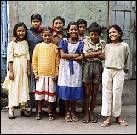|
|
||||
|
|
by Donald Levit  “Intoxicating!” reacted someone after the extra National Board of Review showing, to the mix of scratched bright colors, anthilled humanity, motion, catchy hand-clapping talas and ragas. A world apart, subcontinent British New York-based still photographer Zana Briski is better described as an advocacy photojournalist, and multiple award-winning Born into Brothels begins with her. Two years after a 1995 first trip to During that probationary period, however, the prostitutes’ often fatherless children “were all over me” with their curiosity and need for kindness. On a subsequent trip, she returned with and distributed twenty simple Canon cameras, discussed with the excited children the snapshots they had taken with them, and eventually put her own project on hold in order to teach photo composition and developing and see this world through these young pupils’ eyes. Though she had not previously touched the medium, “Zana Auntie” bought a video camera and started documenting the district and its fearful inhabitants, but particularly the more open children. The results, the youngsters’ enthusiasm and talent, are eye-opening, though when Briski invited documentary editor, producer and director Ross Kauffman to join in making a film about her discoveries, he was reluctant --until she sent him four of her tapes to critique, and he was on board. Produced, directed and filmed by Briski and Kauffman (who also co-edited), Born into Brothels relies on two parallel yet converging stories, connected not only by the girls and boys ten to fourteen, but also by Zana Briski herself, shy and at first aesthetically as well as professionally against appearing in the film. Class outings to a beach or zoo or visits to prospective schools are bright and clean, as are the children’s often unusual photos and proofs or contact sheets, in effective contrast to the still colorful but underlit scratchiness of the district, where filming was sometimes instinctively interrupted as fights or murders occurred. Highlights are benefit exhibits of the children’s work at a Calcutta bookshop and in New York City prior to their being auctioned at Sotheby’s, and a trip made to Amsterdam’s World Press Photo Foundation by twelve-year-old painter Avijit -- who asks to open the KLM window to take in-flight shots -- but these children are sadly wise, too, enough to voice that “there is no thing called ‘hope’ in my future” or that around them “people live in chaos, nobody in other countries lives as filthily.” Cursed at, beaten, abused, pressured into prostitution, these children have so little time, and Briski’s individual efforts to secure their future by getting them away and into decent educational institutions are only somewhat successful. There are fears of AIDS and other illnesses, prejudice against their social status, apathy, unwilling mothers, financial exigency, and a byzantine catch-22 bureaucracy that leaves Briski muttering that “I could kill this ration [card] guy!” Only three of her eight pupils are now in no-nonsense boarding schools of the Sabera Foundation and A plea as much as a movie, Born into Brothels moves one deeply. If it flattens into redundancy near the end, that is because the young lives portrayed will mostly repeat the vicious circle of the past as flames of hope will dim and die. There are so many blighted children, but some at least should benefit from Briski’s non-profit Kids With Cameras (www.kids-with-cameras.org), formed to help desperate children through the “immensely liberating and empowering force” of the art of photography. (Released by ThinkFilm and rated "R" for some sequences of strong language.) |
||
|
© 2025 - ReelTalk Movie Reviews Website designed by Dot Pitch Studios, LLC |



